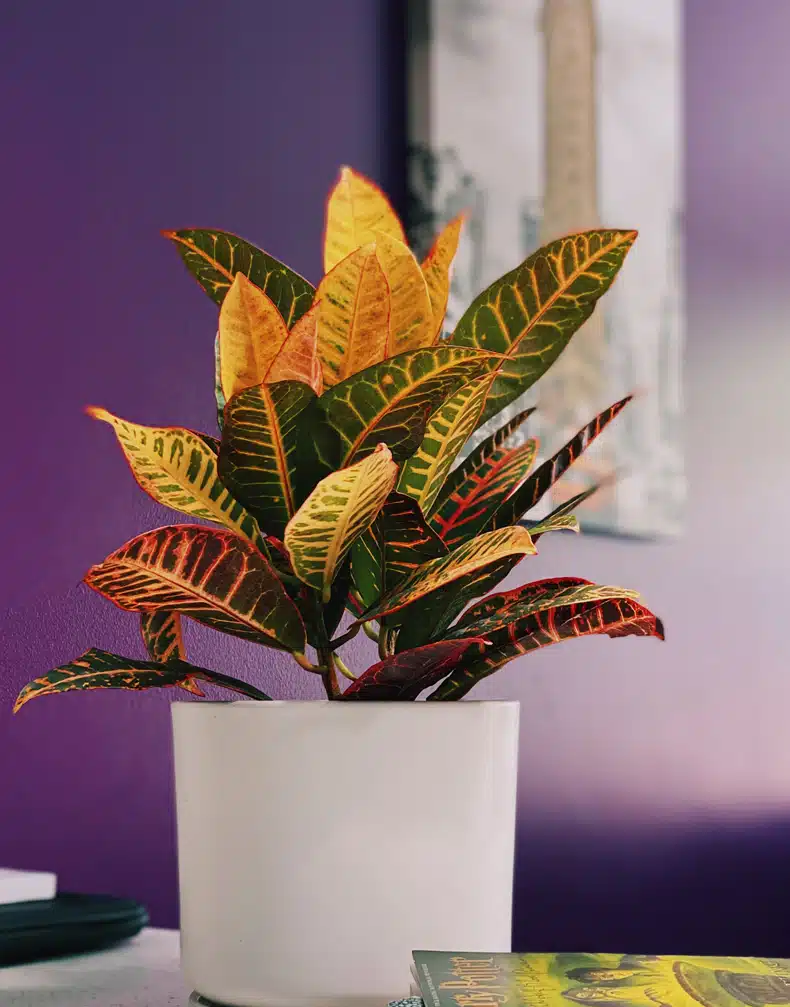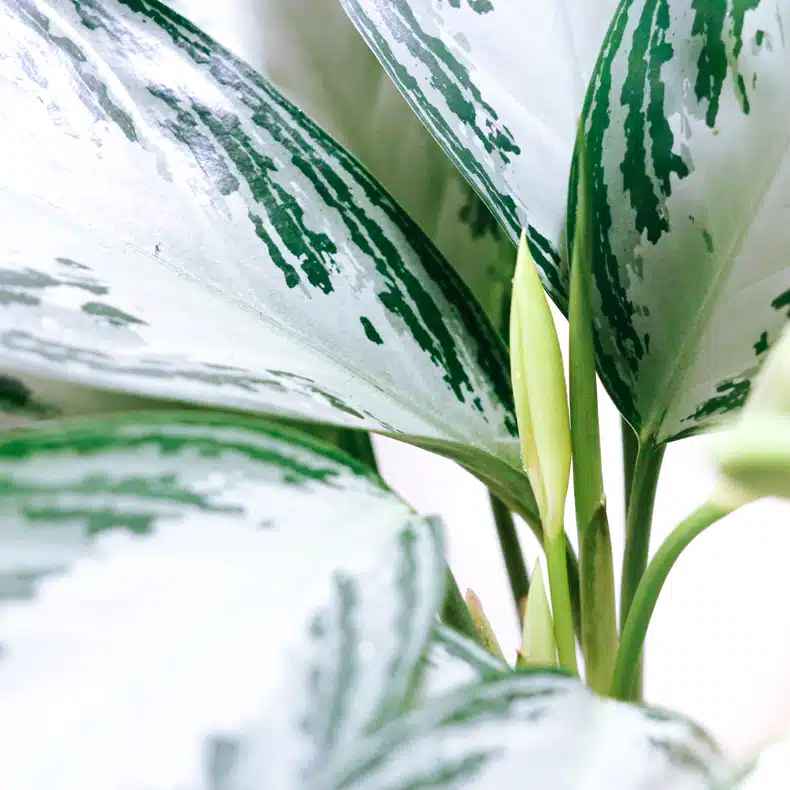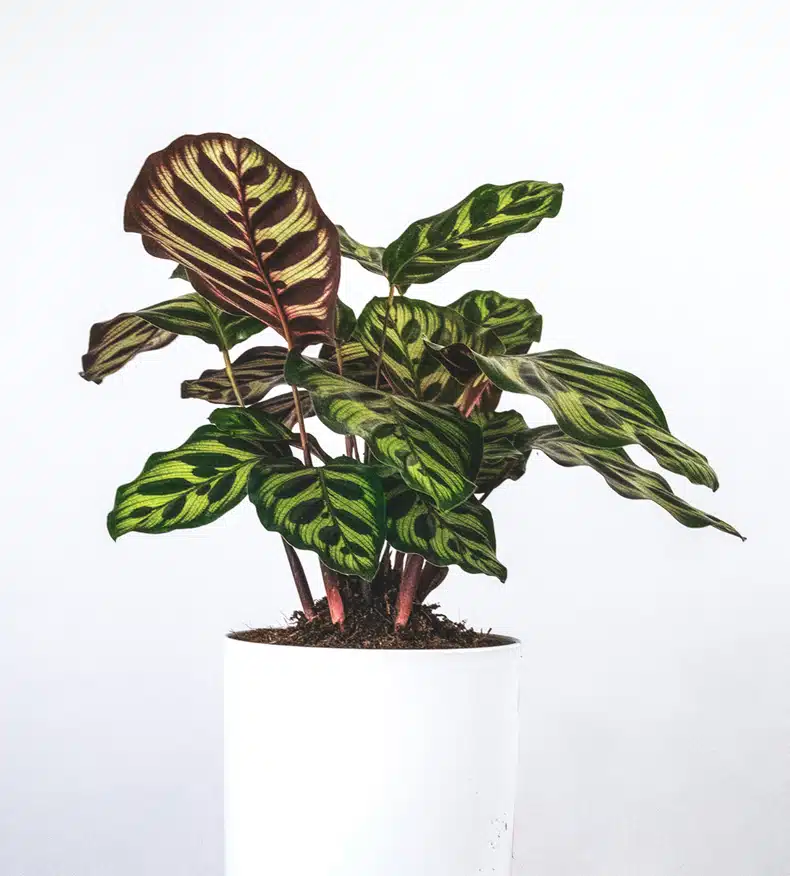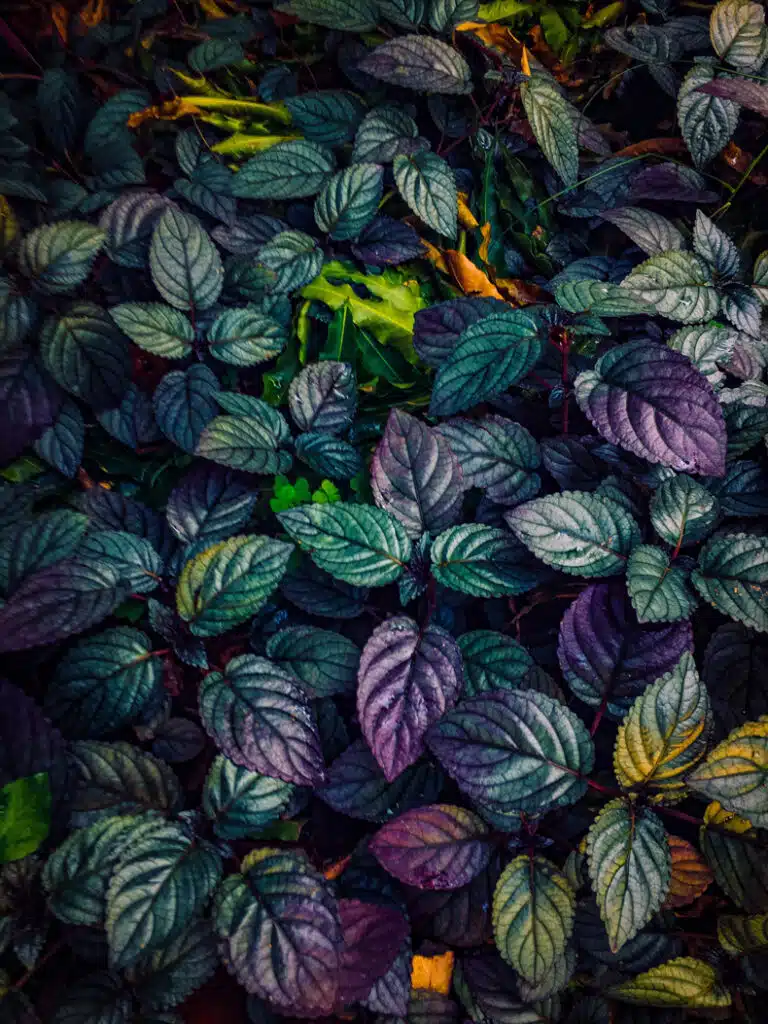Are you looking for a way to liven up your home with some color? Consider adding some indoor plants with colorful leaves! Not only are they beautiful and eye-catching, but they can also help purify the air in your house. Here’s an overview of 10 of the best indoor plants with colorful leaves.

Indoor plants with colorful leaves make a great addition to any home, whether it’s a studio apartment or a large family house. They can be used as accents or centerpieces in any room, providing pops of color and texture. Plus, many of them require minimal maintenance and can tolerate lower light conditions.
Ready to add some life to your space? Read on to discover 10 unique indoor plants with colorful leaves that’ll help transform your living space into something extraordinary!
Adding Color to Your Home with Vibrant Indoor Plants
Caladium

Regarding indoor plants with colorful leaves, the caladium is a great pick. With its vibrant shades of pink, white, and red, this plant makes an eye-catching addition to any home. It’s also known for its low maintenance needs; it thrives in warm temperatures and can survive with indirect sunlight.
The caladium is a tropical plant native to South America, so it’s important that you don’t let it get too cold. If you do, the leaves will start to turn brown and die off. As long as you keep its temperature between 65 and 85 degrees Fahrenheit, however, it should thrive indoors.
You’ll also want to keep the soil moist but not soggy – just water when the top inch of the soil feels dry.
Having a caladium in your home is a great way to bring some color into your space without much fuss or effort. Even if you’re new to houseplants or don’t have a green thumb, this plant is relatively effortless to care for and can live for years if taken care of properly.
All in all, bringing one of these plants into your home could be just the thing you need for an instant pop of color!
Croton

Croton plants are often chosen for their bold and eye-catching foliage. With a variety of colors from yellow to green, red to orange, and even purple and pink, they make great additions to any indoor garden.
These plants are easy to care for, too, since they don’t require too much light or water – perfect for busy people who don’t have much time on their hands.
These brightly colored leaves are also great for creating an inviting atmosphere in the home. Crotons can help bring life into the living room or bedroom with their vibrant hues that stand out against the neutral walls and furniture.
They can also be used as a statement piece at the center of a room or placed in smaller pots throughout the house.
When it comes to buying crotons, you want to make sure you get healthy ones that have leaves without spots or blemishes and firm stems. You’ll also want to look for potting soil that is well-draining yet retains some moisture so your plant can stay hydrated longer.
Make sure you give your croton enough light but not direct sunlight – it should get bright indirect light instead.
Caring for these beautiful plants doesn’t have to be complicated; just follow these few tips and you’ll soon find yourself with a lovely houseplant full of colorful leaves!
Coleus

Coleus is a colorful indoor plant that has leaves in a variety of tones and hues. The leaves come in red, yellow, purple, orange, green, and many other shades. Coleus can be grown in either pots or planted directly into the soil. It needs to be placed near a window to get enough sunlight and should be watered regularly to keep the soil moist.
Coleus is easy to care for and will provide an abundance of color to any interior space. It’s a great choice for those who are just starting out with houseplants because it doesn’t require too much maintenance.
As to watering, it should only be concedered when the top inch of soil feels dry to the touch. Too much water can cause root rot in this type of plant.
In addition to its vibrant colors, coleus also provides a pleasant fragrance which is sure to add an extra layer of enjoyment for anyone who gets close enough to appreciate it.
Its flowers may not be showy but they have a subtle beauty that adds charm and character to any room they inhabit. With proper care, this plant can thrive indoors for years without requiring too much effort from its owner.
Chinese Evergreen

Chinese evergreen is a beautiful indoor plant with colorful leaves. It’s an easy-to-care-for houseplant that can thrive in low light and requires minimal water.
The variegated leaves of this plant come in shades of green, white, silver, and even pink. Plus, chinese evergreen is known for its air purifying abilities.
The best thing about chinese evergreen plants is how quickly they adapt to their environment. Even if you don’t have the perfect conditions for your plant, it will still survive and do well.
For example, you can keep it in low light or bright indirect sunlight and it will still thrive. It also doesn’t require a lot of water to stay healthy–just water it once a week or when the soil feels dry to the touch.
If you’re looking for an easy-to-care-for houseplant that has beautiful foliage and air purifying benefits, chinese evergreen might be the right choice for you!
With its colorful leaves and tolerance of low light conditions, you’ll have success with this hardy houseplant indoors or outdoors on your patio or balcony.
Peacock Plant

The Peacock Plant is a great choice for adding color and vibrancy to an indoor space. It’s leaves are striped with hues of pink, red, and green, making it a truly eye-catching addition to any home or office. The plant is relatively low-maintenance, requiring only indirect sunlight and occasional watering.
This species of plant is a member of the Marantaceae family and can reach heights of up to two feet. So not only does this plant provide a beautiful splash of color, but it can also help to fill in large indoor spaces with greenery.
Plus, its hardy nature means it can tolerate weeks without being watered or re-potted so it’s perfect for those who tend to forget about their plants.
When grown indoors, the Peacock Plant usually produces flowers in shades of yellow or white – making them an even more attractive feature!
As a bonus, they have been known to attract beneficial insects like butterflies which help pollinate your other houseplants and add life to your environment. With its stunning foliage and NO-FUSS care requirements, this colorful plant is sure to be loved by all who see it!
Red Aglaonema

The red aglaonema is an attractive and popular choice for an indoor plant with colorful leaves. It’s a robust plant, able to withstand low light conditions and occasional neglect.
Its vibrant foliage adds a splash of color to any room while its evergreen nature ensures that the colors will last all year round.
This plant has lance-shaped leaves that can range from green to dark red, depending on the variety you choose. The colors are usually bright and vivid, making it a great option for adding vibrancy to a dull or plain living space.
Plus, it’s relatively easy to care for; just keep it in well-draining soil and water when the soil starts to dry out.
Overall, the red aglaonema is an excellent choice for anyone looking for an indoor plant with colorful leaves. Its eye-catching foliage will brighten up any home or office and its low maintenance requirements mean that it won’t require extra attention from its owners.
Whether you’re looking to add some pizzazz or simply bring life into your home décor, this plant is sure to do the trick!
Purple Waffle Plant

The purple waffle plant is a perfect choice for an indoor plant with colorful leaves. It has a unique look and texture, with attractive purple and green foliage that looks almost like waffles.
The bright colors of the leaves make it great for adding a splash of color to any room.
Unlike some plants, the purple waffle plant is quite low maintenance. It doesn’t need too much water, so you won’t have to worry about over-watering or having to constantly check on your plant. Plus, it’s fairly resistant to pests and diseases, so it’s not likely to get sick or die easily.
On top of that, the purple waffle plant can be propagated easily through stem cuttings. This means that you can easily create more plants from your existing one.
Just take a stem cutting and place it in water or soil to propagate a new one! With this kind of easy propagation ability, you can quickly turn your single houseplant into multiple plants in no time at all.
Overall, the purple waffle plant is an ideal option for anyone looking for a beautiful yet low maintenance indoor plant with colorful leaves. Its unique combination of vibrant colors and easy upkeep makes it perfect for brightening up any space without much effort!
Calathea Orbifolia

The calathea orbifolia is a stunning indoor plant with colorful leaves. Its bright green oval leaves have purple undersides, and its look is completed with a white border. This eye-catching foliage makes it a great addition to any home or workspace.
When caring for the calathea orbifolia, you’ll want to keep it in medium to low light and away from direct sun. It prefers moist soil that drains well, so be sure to water frequently but don’t let the soil get soggy. Additionally, high humidity and regular misting are essential to keeping this plant healthy.
If you’re looking for a unique indoor plant with plenty of personality, consider adding the calathea orbifolia to your space. Its striking foliage will add texture and color without taking up too much space, making it perfect for those tight spaces that need some livening up. Plus, its maintenance requirements are relatively simple – just make sure you provide it with the right lighting and humidity levels!
Dracaena Marginata

Dracaena marginata, otherwise known as the Madagascar dragon tree, is an easy-to-care-for indoor plant that produces colorful leaves. It’s a great pick for homes and offices alike due to its low light requirement, as well as its relatively small size. With its bright green leaves edged in red and pink hues, the dracaena marginata adds a bold pop of color to any room!
When caring for this houseplant, consider providing it with plenty of indirect light and watering it when the soil feels dry. Dracaena marginata also requires moderate humidity levels to stay healthy.
If you have an area in your home or office that tends to get a bit dry, adding a humidifier can help keep your plant happy. Additionally, be sure to check your plant regularly for pests like mealybugs or spider mites, which can damage the leaves if left unchecked.
If you’re looking for an easy-to-care-for indoor plant that makes a statement, then the dracaena marginata should be on your list! This evergreen shrub is not only beautiful but also relatively low maintenance compared to other houseplants. With its bold colors and ease of care, it’s no wonder why this popular houseplant will make a great addition to any home or office!
Rubber Tree

The rubber tree is an excellent choice for those looking to add a splash of color to their indoor garden. With its unique blend of green and burgundy leaves, it’s sure to make any room look beautiful. Plus, it’s easy to maintain: just keep it away from direct sunlight and water when the soil starts to feel dry.
Not only does this plant provide a lovely aesthetic, but it also has other beneficial qualities. For one thing, rubber trees are very effective at filtering out toxins like formaldehyde and benzene from the air. This can help improve air quality in your home or office, making for a healthier environment overall.
Additionally, the rubber tree is known for being relatively low-maintenance compared to other houseplants; you won’t have to worry about constantly checking up on it!
If you’re looking for an attractive indoor plant that doesn’t require too much effort on your part, then the rubber tree is definitely worth considering. It will brighten up any space with its colorful leaves while also helping keep the air clean and fresh – what more could you ask for?
Frequently Asked Questions
What Kind Of Soil Should I Use For These Plants?
When choosing soil for indoor plants with colorful leaves, there are a few things to consider. The type of soil you use can have a tremendous impact on the health and vitality of your plants. If you’re not sure what type of soil to use, it’s best to do some research and find out what type is most suitable for your plant.
How Often Should I Water These Plants?
Watering indoor plants is essential for keeping them healthy, and the frequency of watering depends on the type of plant. As a general rule of thumb, most houseplants should be watered every 7-10 days. However, this may vary depending on the variety of plant and its environment.
Overall, it’s important to pay attention to how often you water your plants as too little or too much can lead to wilting leaves or root rot. To help determine when to water your indoor plants with colorful leaves check the soil regularly and adjust accordingly – if it feels dry then give them a good drink!
Are Any Of These Plants Toxic To Pets?
When it comes to indoor plants with colorful leaves, one of the most important questions that pet owners need to consider is whether or not any of these plants are toxic. After all, curious pets may be tempted to nibble on the leaves, and ingesting a toxic plant can lead to serious health issues for your furry friends.
How Do I Propagate These Plants?
When it comes to indoor plants, many of us are drawn to their vibrant and colorful leaves. But beyond having an attractive look, many of these plants can also be propagated. So how do you go about propagating your favorite colorful indoor plant?
It’s important to determine the best method for propagation for your specific plant. Each type of plant has different requirements and needs for propagation. For example, some plants require division while others are better suited to stem cuttings or even root division. Researching your particular species of indoor plant is essential in determining the best method for successful propagation.
What Type Of Light Do These Plants Need?
When it comes to indoor plants with colorful leaves, light is important. It’s essential to provide enough light for these plants in order to keep them vibrant and healthy. So, what type of light do these plants need?
The amount of light a plants need depends on the type of plants, but most indoor plants with colorful leaves can thrive in bright indirect sunlight or filtered sunlight. When looking for the best places for your plant, make sure it’s close to a window that gets plenty of natural light throughout the day. You also want to be sure to avoid direct sunlight as this can damage the plant’s leaves.
Conclusion
In conclusion, it’s important to consider the specific needs of these plants before bringing them into your home. Knowing how often to water the plants, what type of soil and light they need, and if they’re toxic to pets is essential for keeping them healthy.
I’d also suggest researching how to propagate the plants so that you can enjoy their colorful leaves even more. Taking cuttings from the new growth on each plant will ensure that you get as many as possible.
In the end, having vibrant foliage in your home is a beautiful way to add life and color to any space. It’s worth taking some time to find out exactly what each plant needs so that you can enjoy their beauty without worrying about damage or harm coming to them or anyone else in your household.
And follow Quiet Minimal on Pinterest for more home design tips and inspiration.



